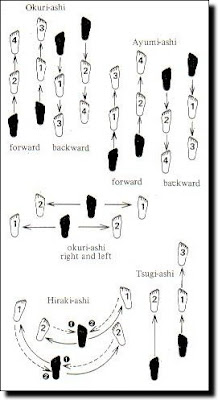Ashi sabaki - footwork
Footwork is the base of kendo. Without good footwork, you cannot get better in kendo.
Actually in Japanese ashi means leg as well as foot, so we could say it's called "leg-and-footwork". To have good ashi-sabaki, you must develop strong legs and feet. Personally I believe it is more important to have a strong lower body (which includes stomach, hips and lower back) than a strong upper body (chest, shoulders and arms). For this reason I strongly recommend cycling or running as important training for kendo development.
There are two main kinds of footwork as you know: ayumi ashi and okuri ashi. Both use a kind of suri-ashi or sliding action across the floor. As you know also, the heel is not used in kendo except at the moment of cutting. At that moment the footwork is called fumikomi ashi.
The left foot
The secret to achieving excellent footwork in kendo is the left foot. If you can bring the left foot up quickly to the start position, you will be ready more quickly to take the next step. The left foot is very much the driving force in propelling you forward. I think of it as having a rear-engined, rear wheel drive car, like a Porsche. The engine in the back drives you forwards.
When going backwards it becomes the right foot which drives you backwards. In both cases we say it is the trailing foot that is provides the power.
The left knee
When you face an opponent in kamae, the left knee is very important. In kendo it is said that, "wherever you point your left knee, that is where you will go". Therefore it is important, as you and your opponent move around in shiai or jigeiko, always to keep your left knee pointed at your opponent.
The left knee should be slightly bent, relaxed, but filled with power. A weak left knee will bend when your opponent applies pressure or seme. Bending the left knee when in kamae will cause you to lean backwards. This is what creates the appearance that you are being overwhelmed by your opponent, and indeed this is exactly what is happening!
Both knees should be slightly bent, relaxed and ready to move, but not about to buckle. In my own words I would say your knees should be "braced but not locked". Whether that makes sense to anyone else I'm not sure. This is a very difficult thing to explain and can only be learned through your own practice. However it is a good thing to think about.
Fumikomi ashi
This is an area that a lot of people have trouble with, even after they are confident with the rest of their footwork. However thinking through the basics and practicing them carefully will help you learn the correct way.
The secret is again the left leg and foot. With fumikomi ashi the main difficulty lies in smoothly linking the big fumikomi step with the continuous okuriashi steps of your zanshin. If you can quickly bring your left foot up, you will be able to stop yourself 'falling in a hole'. If you are having real difficulty over a long time with this, it may be because you are trying for too big a leap with your fumikomi. Go back to only doing short fumikomi and you will find it easy to link it with your zanshin. Then gradually lengthen your fumikomi until you can both cover a lot of ground and also follow through smoothly. Remember if you have been away from training you might need to go back to short fumikomi while you get your strength back.
Needless to say the right foot should never come very high off the ground and you should always strike the ground with the whole right foot flat when you do fumikomi ashi.


Comments
Thanx for this well written article. Very helpful and always be a guide, a good guide, to review it many, many times in future.
Thanx,
José Vargas.